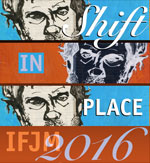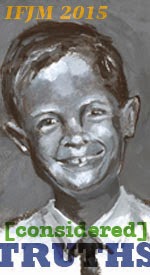Keep in mind that in order to get your April experience going you will need to do a little bit of work in the next couple of days to prepare—you'll need to sit with your REAL journal and ask yourself a few questions so that you can avoid the same issues in your fake set up.
Here's my advice:
IFJM can be a great tool for fighting blockage, for really looking at the cause and finding ways to work around it in your life.
Be sure to find a way to really limit the time involvement you require each day for your fake journal so that working in the journal doesn't become yet another instigator of blockage, e.g., "I don't have time for the fake journal I really have to do such and such."
Find something that you can do in 15 minutes or less.
Think about a character who always puts art or observation first. Imagine what it's like to have a regular appointment for that 15 minutes, or set up situations for the month where you will have outings or instances where you will have 15 minutes at odd times to sketch and journal.
I would also suggest you keep you supplies to a minimum so you aren't side-tracked with thinking "which medium will I use today?"—picking one medium to use for the whole month and to explore with is something totally doable in 15 minutes a day.
Also think of what it is you want to say and do in your REAL journal and then ask yourself why you don't do that. (This is best done before IFJM begins. Set an appointment to write, or also do it in small bursts of time as thoughts come to you during the day—just write down what pops into your head and look at it all at the end of the day.)
Next think about a character who 1. either doesn't want to do those things in his/her journal so you'll do the exact opposite of what YOU would do during the month in his or her journal, or 2. someone who does those things and what does that person's life look like? All of that will help you get into the character for 15 minutes a day.
And lastly realize that your character is going to have a totally different dialogue with his/her internal critic because he/she isn't blocked. What is that dialog like? That character won't write or journal about that because it is just a fact of life, so you might, when you think of this (maybe before you go to bed at night) take a few minutes to write in your REAL journal about that.
Remember habit building happens in 28 days. It's more important to get something done in the habit building time than to create something great! First you have to get the habit in place. That's another reason IFJM and fake journals are a good way to start a journaling habit—because you are doing something daily for 30 days. (Remember you don't run a record marathon your first day of training, you may only run around the block. If you're using IFJM to break a creative block on journaling focus on running around the block each day, the rest will come later after you have the habit.)
Also keep in mind that life happens. If you're using IFJM to combat a tendency not to journal and already have a habit of avoiding or putting off journaling when life happens you'll need to work harder to avoid that habit during IFJM and find ways to meet that 15 minutes a day you've set for yourself. That will be difficult for most people in this situation.
And it will feel UNCOMFORTABLE, because breaking a habit (here the habit of avoidance) is an uncomfortable process. Habits (either good or bad) feel good and comfortable to our minds and our bodies because they are habits (ask anyone who's ever tried to change his life in the smallest way). But if we persevere in the breaking of bad habits, by creating new habits, we have much to gain. It's worth a bit of discomfort.
If your blockage is not about journaling but instead is about using one particular medium or one technique more the equation is a bit simpler—you simply substitute that medium or technique into the time you already spend journaling, just for the month. This doesn't mean you won't do any regular journaling, but you may find you do less of that in April. Any habit change is going to take some accommodation and adjustment in the rest of our life.
Again, it might feel uncomfortable to use the different medium you elect to stick with, or it might be difficult to start at the beginning with a new technique. You are still breaking out of your comfort zone and your internal critic is going to jump out and let you have it.
All your character latitude to deal with the internal critic in his or her own way—you might learn some new techniques you can bring back to your real life.
Remember too to be kind to yourself. If you miss a day don't beat yourself up. Just make sure you work first thing the next morning, or set a watch alarm for a time later in the day and keep that appointment regardless of how you feel at the time. It's "just do it" time. Get into your character's mode. Remember too that your character doesn't have blockage, doesn't have a reason to stop so you can be assured that the next day he/she won't even see today's miss as a blip on the grand continuum of life. That's where you want to put your focus too, on that continuum.
One more thing. However wonderful it may be to share your work with others as you go through this journey, and however much you count on people's support when you share your work, if you are working on a block of any sort it may be best not to share your work during April.
I tell my journaling students this about their regular journaling work all the time when I have multi-session classes where we work on good journaling habits. It's fine to share work within the confines of the class where everyone is working on the same plan and developing good boundaries, positive "critique" methods, and understands what the goals are. But in the general world, and even in your own family there will be people who just don't "get" what you're up to.
Would you rather spend all of April not just explaining to those people that you want to journal more and why that is, but why you're using IFJM to find a way to do it? Or would you rather get down and busy at actually changing something?
Why risk a stray comment from someone who actually might even mean well—a comment which could derail you?
If it's time to do serious work and you don't already have good boundaries and techniques for dealing with your internal critic the best time to share your fake journal is in MAY, AFTER IFJM is over.
Why? Because then no comments can derail you. You're already finished with the project. And you hold it in your hand. You know exactly what it took for you to do it. You may never be able to explain to anyone what it took, or how you even did it, but you don't have to. You just need to know that you did it. And that's the gift you give yourself for getting through the month.
Besides, this year it's "NO Explanations" remember?!
So think about those considerations to as you set up your plan for IFJM 2014. Good luck.











